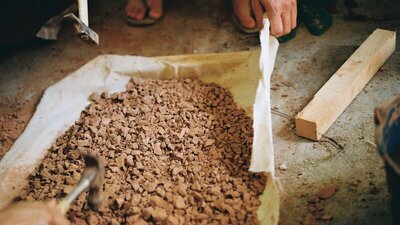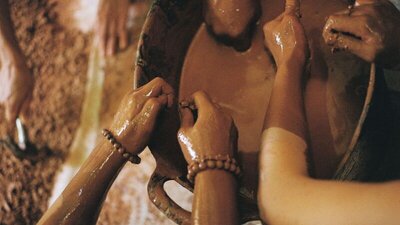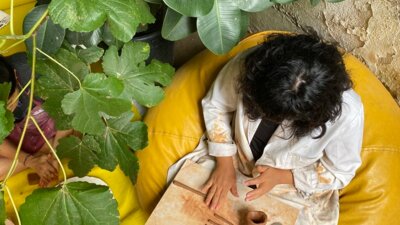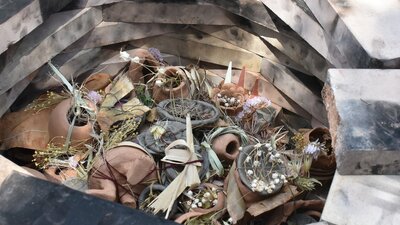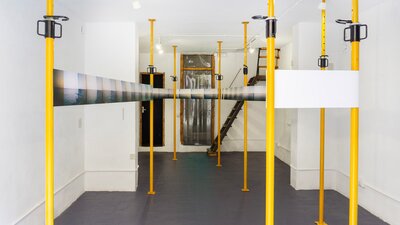
resolution
Call for applications for internal artistic research grants - La Escocesa 2024
After a selection process involving 15 applications, the jury, made up of Renata Cervetto, Jesús Arpal Moya and Alba Colomo, has decided to select the following projects as part of the internal call for applications for La Escocesa 2024 artistic research grants:
- Andi Icaza Largaespada
- Fabrizio Contarino
Jesús Arpal Moya and Renata Cervetto have accompanied these projects during the months of their development. Below is a brief summary of the development of these grants:
andi icaza largaespada y Sara Yaoska Herrera Dixon - Vasijas para sembrar duelos [Vessels for sowing grief]
andi icaza-largaespada (Amiskwacîwâskahikan, 1994) is a Nicaraguan visual artist, researcher, and facilitator with connections and responsibilities in Central America, so-called Canada, and queer and displaced communities in the Global South. Their multidisciplinary practice crosses image, installation, materialities, and ritual, developing a poetic, political, and affective ecology of dissident (dis)orientations to grief, migration, history, and territory that seeks to articulate situated, translocal, and embodied narratives, and forms of resistance to extractivism and necropolitics. She collaborates constantly with human and more-than-human beings, in life, past and future, and bases her (continuous) learning on the territory, among peers, and with mentoring, among others.
On the other hand, Sara Yaoska Herrera Dixon's practice understands language, materials and stories from a spatial perspective. She is interested in where concepts come from, how they migrate, adapt, adopt and land in different realities and bodies. She co-constructs specific spaces and processes according to each context, which aim to be ethical, poetic, political and aesthetic in order to think, imagine and create together. This practice is nourished by her experiences and emotional ties in Nicaragua, the United Kingdom, and the city of Barcelona. A graduate in Architecture and Interdisciplinary Studies from the Bartlett School of Architecture UCL, University of London, she focused on architectural theory and research, design/art, and film studies. She currently works on architecture/art publications and collaborates with other artists, researchers, and curators.
The artists conducted research based on collaboration and the exchange of experiences and sculptural techniques “to knead the lands we carry, the lands that carry us, and the grief that facilitates the passage of their porosity.” Using the potential for life in the void of porosity as a methodology, this exploration injects ideas of continuities and cycles into the dualities of life-death, absence-presence, and earth-sky, rather than opposition. The project is structured as a laboratory in which, through a trial-and-error approach, different methodologies are tested that seek to integrate the rhythmic, plastic, and aesthetic patterns of ceramics with reflections on displacement, mourning, and regeneration. The research and workshop design process were supported by Renata Cervetto.
The research began with field visits to Nindirí, Nicaragua, in December 2024, where Chorotega pre-colonial funerary urns were studied closely, producing audiovisual documentation and charcoal frottages. During the first months of 2025, they experimented with dry clay from La Escocesa, recycling it to create test bodies that explore forms and symbols from archaeological and embodied bibliography, accompanying conceptual and sensitive discussions with the rhythm and plasticity of the material.
Following the experimentation, a group laboratory was held to collectivize and root the research process in the community, called Vasijas para sembrar duelos: un taller en tres movimientos. It took place over three consecutive Saturdays in July, at La Escocesa and Cal Negre, El Prat, with the support of Maria Roy. The three movements were: Preparar la tierra, Zurcar, y Sembrar en fuego, which included clay regeneration, parasitic reading, guided meditation, molding pieces, building a kiln, dressing the pieces, and their first burial in the kiln. The closing of the laboratory in Cal Negre featured a collective meal incorporating local ingredients and others of cultural importance in Nicaragua, Central America, and the Caribbean, prepared by gastronomic artist Yazel Nahems Parra.
Fabrizio Contarino - Paisajes de control [Control landscapes]
Fabrizio Contarino (Italy, 1976) is a visual artist and researcher based in Barcelona. His work explores the intersection between the documentary and the speculative, reflecting on belonging, identity and memory, and on the relationship between image and space, gaze and scene. He has participated in the Temporals programme of Barcelona Cultura (2024) and has exhibited in Europe, Asia and Latin America. He currently directs Espai Souvenir and is a partner at La Escocesa.
Paisajes de Control (Control landscapes) is a research project that explores the interaction between concrete infrastructures on the Mediterranean coast and natural landscapes. Through an experimental approach, it investigates how these constructions act as tools of control that transform the landscape and affect both the ecology and the daily lives of people. As part of the research, he produced Líneas de Fuga, a photographic installation that emerges from a visual and geographical drift around the island of Pantelleria, an enclave between Europe and Africa in the Mediterranean. Through superimposed images, the work explores a fragmented and constantly reimagined horizon, moving away from any idea of stability.
The island's perimeter road, originally built for military surveillance purposes, now serves as a control route and visual exploration platform. The photographs, conceived as a continuous sequence using analogue double exposure, condense different movements and perspectives into a single plane, transforming linearity into circularity and dissolving apparent continuity into elusive fragments. Inspired by Deleuze and Guattari's notion of creative deterritorialisation, the work converts what was once a mechanism of supervision into a space of perceptual drift, where the boundaries between observation and reverie, cartography and wandering are blurred. Líneas de Fuga proposes an unstable and vibrant horizon, traversed by fractures and divergent perspectives.


